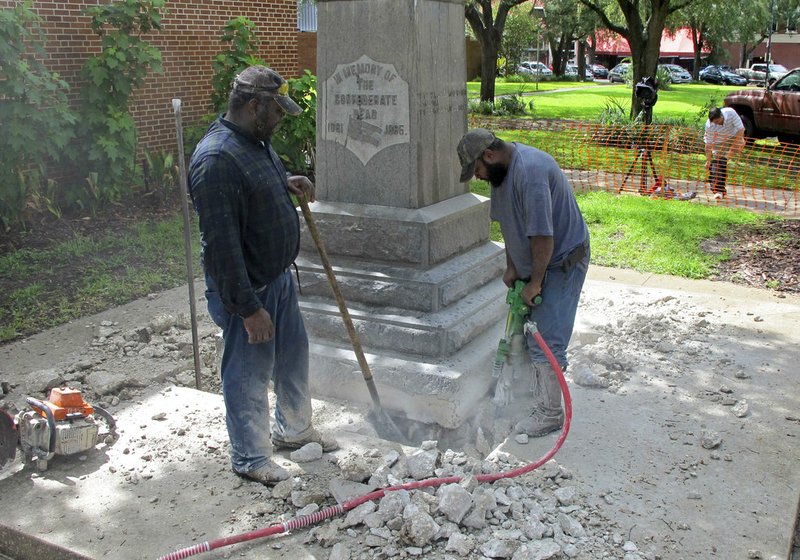In Gainesville, Fla., workers hired by the Daughters of the Confederacy chipped away at a Confederate soldier's statue, loaded it quietly on a truck and drove away with little fanfare.
In Baltimore, Mayor Catherine Pugh said she's ready to tear down all of her city's Confederate statues, and the city council voted to have them destroyed. San Antonio lawmakers are looking ahead to removing a statue that many people wrongly assumed represented a famed Texas leader who died at the Alamo.
Some people refused to wait. Protesters in Durham, N.C., toppled a nearly century-old statue of a Confederate soldier Monday at a rally against racism. Activists took a ladder up to the statue and used a rope to pull down the Confederate Soldiers Monument that was dedicated in 1924. A diverse crowd of dozens cheered as the statue of a soldier holding a rifle fell to the ground in front of an old courthouse building that now houses local government offices.
The deadly white nationalist rally in Charlottesville, Va., is fueling another re-evaluation of Confederate statues in cities across the nation, accelerating their removal in much the same way that a 2015 mass shooting by a white supremacist renewed pressure to take down the Confederate flag from public property.
"We should not glorify a part of our history in front of our buildings that really is a testament to America's original sin," Gainesville Mayor Lauren Poe said Monday after the statue known as "Old Joe" was returned to the United Daughters of the Confederacy, which erected it in 1904.
A county spokesman said he did not know if the statue was removed because of the events that killed one person and injured dozens more Saturday in Charlottesville. But many officials who were horrified by the confrontation soon began publicizing plans to take down statues.
The Southern Poverty Law Center last year counted more than 1,500 things around the country named after Confederate figures or dedicated to the Confederacy, including holidays, statues, flags and the names of cities, counties, schools and parks. Nearly half are monuments, which are in 24 states. Most of the dedications are in the South, but 24 are in the North and 21 in states that did not exist at the time of the Civil War.
In Jacksonville, Fal., City Council President Anna Brosche ordered an immediate inventory of all of the Confederate statues in her city in preparation for their removal.
"These monuments, memorials and markers represent a time in our history that caused pain to so many," she said Monday.
Lexington, Ky., Mayor Jim Gray moved up his announcement by a day in reaction to the weekend bloodshed. Memorials to John C. Breckinridge and John Hunt Morgan are perched outside a former courthouse that was the site of slave auctions before the Civil War.
San Antonio Councilman Roberto Trevino is promoting a measure that would remove the Confederate statue at the center of Travis Park, where for years people have mistakenly identified the figure as being that of Col. William Travis, a Texas hero who died at the Alamo.
"This is not an important art piece, but a monument to power. It was put in to remind people of that power. It is an unfortunate message of hate, and we think it's important to relocate it." Trevino said Monday. "We do think that history is important so we're looking for an appropriate location for it."
St. Louis dismantled its Confederate Monument in Forest Park in June, giving it to the Missouri Civil War Museum after years of debate.
In Memphis, city attorney Bruce McMullen said Monday that he plans to file a petition to remove a statue of Nathan Bedford Forrest, a Confederate cavalry general and an early leader of the Ku Klux Klan, from a park. The Memphis City Council voted in 2015 to relocate the statue, but the state historical commission blocked the move under the Heritage Protection Act, which makes any push to remove historical markers harder.
In Nashville, protesters draped a black jacket over the head of a Forrest bust at the Tennessee Capitol while cheering, "Tear it down!" Republican Gov. Bill Haslam later said he didn't think Forrest should be honored at the Capitol.
In Baltimore, Pugh said Monday that she would move forward with the removal of Baltimore's statues of Roger B. Taney, a Marylander who wrote the 1856 Dred Scott Supreme Court ruling that denied citizenship to African-Americans, and a statue of two Virginians, Confederate generals Robert E. Lee and Thomas "Stonewall" Jackson.
Pugh said she was making plans to send the statues to cemeteries with Confederate dead outside the city. But hours later, the city council voted unanimously to have the statues destroyed instead of moved. It was unclear whether anything would happen to the statues immediately.
Seconds after the monument fell in Durham on Monday, protesters began kicking the crumpled bronze monument.
In response, Democratic North Carolina Gov. Roy Cooper tweeted: "The racism and deadly violence in Charlottesville is unacceptable but there is a better way to remove these monuments."
Back in May, New Orleans Mayor Mitch Landrieu moved his city's four main Confederate statues, including a statue of Lee, at night after threats of violence from Confederate sympathizers and white supremacists. Pugh said she is consulting with Landrieu, now head of the U.S. Conference of Mayors, about the removal of Baltimore's statues and the cost.\
